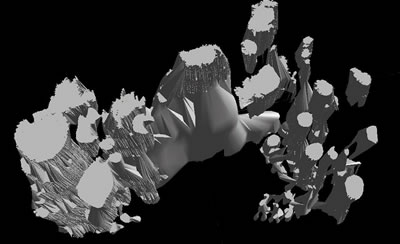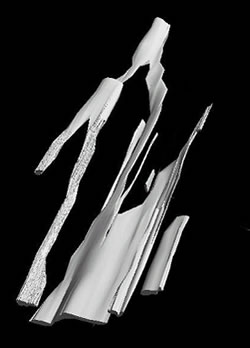|
BERKELEY, CA — Hoping to track cancer as it spreads
cell-by-cell through the body, Lawrence Berkeley National Laboratory researchers
have developed a way to shape high-resolution microscopy images into three-dimensional
renditions of tissue such as mammary ducts.
The result is a microscopic look at the molecular and genetic underpinnings
of cancer on a glandular scale. The system, which couples a computer-assisted
microscope to powerful visualization programs, stacks two-dimensional
microscopy images into a lifelike structure packed with genes, hormone
receptors, and proteins. It could ultimately portray how cancer spreads
from a few anomalous cells to millions of cancerous cells radiating throughout
a gland. It could also map the cellular degeneration of diseases such
as Alzheimer's and Parkinson's as they ravage surrounding tissue.
"In the future, we could analyze any three-dimensional tissue sample
for its genetic and cellular activity," says Carlos Ortiz de Solorzano,
a staff scientist in Berkeley Lab's Life Sciences Division who helped
develop the technique. "We'll more easily relate morphology with
molecular events."
|
 |
|
| Tumor masses are portrayed as gray volumes in this
three-dimensional surface rendering of a breast biopsy with ductal
carcinoma in situ. The image can be rotated and magnified, and each
volume can be individually selected. |
|
In conventional microscopy, tissue is sectioned into ultra-thin segments,
and stained with a chemical marker that highlights a genetic phenomenon
indicative of a specific pathology. To image a type of breast cancer called
ductal carcinoma in situ, for example, breast tissue is stained with a
marker that only adheres to the amplified form of a gene called Her2 --
an indication of cancer.
Researchers then search for this chemical marker under a microscope,
which allows them to see which cells in each two-dimensional section are
potentially cancerous. But if they want a broader picture, such as the
extent to which cancerous cells have wormed throughout the tissue, they
must mentally stack several microscopy images together. Complicating matters,
tissue samples are often stained with a palette of chemical markers to
accentuate different cells. Mentally keeping track of each color in a
series of microscopy images is difficult. Now, a computer does it for
them.
"We've streamlined the acquisition, reconstruction, and analysis
of large tissue samples," says Ortiz de Solorzano. "It's far
better than mentally reconstructing images, which is nearly impossible."
There are other ways to map the three-dimensional spread of disease,
such as the medical imaging technologies magnetic resonance imaging and
positron emission tomography. Although highly accurate, and the only way
to non-invasively image disease in patients, these techniques only capture
blood flow and metabolic changes that indicate disease. Changes to individual
cells go unnoticed. Another method, called confocal laser scanning microscopy,
can track the genetic activity of individual cells, but only in relatively
thin tissue samples. Berkeley Lab's system encompasses cellular resolution,
three-dimensional reconstruction, and multicolor display of thick tissue
in a single, computer-automated process.
So far, Ortiz de Solorzano's team has used the technique to map the distribution
of amplified Her2 genes in a tissue biopsy of ductal carcinoma in situ,
which invades mammary ducts. They're searching for cells with pronounced
Her2 genes that somehow sprout far from the tumor in otherwise healthy
tissue. Finding these isolated, abnormal cells, and determining the pattern
by which they spread, could offer the earliest indication that a tumor
may be invasive.
"The question is: is the tumor emitting some kind of field effect
and influencing cells far way, or has a cell broken off from the main
tumor?" Ortiz de Solorzano says.
To answer this question, researchers must cast a wide net. The carcinoma
must be microscopically imaged, as well as the surrounding tissue in all
directions. The trick is to capture a breast tumor and these lone, abnormal
cells in the same image, which could offer a window into their poorly
understood relationship. Unfortunately, conventional microscopy only images
a two-dimensional slice of tissue, and only the luckiest slice harbors
both carcinoma and abnormal cell.
"If cells have broken from the main tumor and invaded the ducts,
there's a good chance you won't capture them," Ortiz de Solorzano
says. "You're ignoring the tissue's 3-D structure."
But if a series of images are digitally stacked into a gland-size shape,
the carcinoma and its widely scattered orbit of abnormal cells takes shape.
In this manner, a computer, not a brain, does the heavy work and makes
sense of cancer's heterogeneous sprawl of cells.
|
 |
 |
|
| Gray volumes represent normal ducts in this partial
three-dimensional surface rendering of a mouse mammary gland. A single
duct and its branches can be traced throughout the gland, and areas
targeted for high-resolution analysis can be selected from the image. |
|
Ortiz de Solorzano's team is also using their technique to model the
activation of estrogen and progesterone hormone receptors throughout the
development of a mammary gland. They're examining chemically labeled mouse
tissue samples at several week intervals, and asking key questions: Do
progesterone-positive cells usually appear next to estrogen-positive cells?
Do they appear first in large ducts, or small ducts? They hope to learn
how these receptors, which are critical to normal breast tissue function,
are distributed throughout tissue. And they're interested in how these
receptors express differently in cancerous tissue. With conventional microscopy,
such an inquiry requires taking flat sections and extrapolating how they
appear in three dimensions -- possible, but very time consuming.
"With our technique, however, we can more quickly look at receptor
development in entire glands," says Ortiz de Solorzano. "And
cancer is fundamentally a cellular and tissue disease, so it must be examined
in three dimensions. The more quickly we can do this, the faster we'll
understand it."
Their technique is described in the paper "A system for combined
three-dimensional morphological and molecular analysis of thick tissue
specimens," which appeared in the December 15, 2002 issue of Microscopy
Research and Technique. Computer scientists Enrique García
Rodriguez and Arthur Jones, and graduate student Rodrigo Fernández-González,
contributed to the research.
Berkeley Lab is a U.S. Department of Energy national laboratory located
in Berkeley, California. It conducts unclassified scientific research
and is managed by the University of California.
Additional information
More
about Carlos Ortiz de Solorzano's research
|

